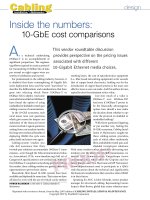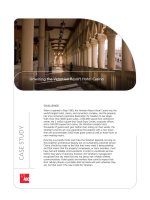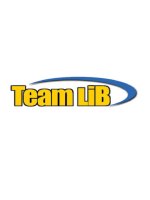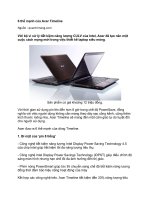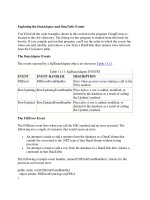Tài liệu Unwiring the Venetian Resort Hotel Casino docx
Bạn đang xem bản rút gọn của tài liệu. Xem và tải ngay bản đầy đủ của tài liệu tại đây (133.04 KB, 3 trang )
CASE STUDY
Unwiring the Venetian Resort Hotel Casino
CHALLENGE
When it opened in May 1999, the Venetian Resort Hotel Casino was the
world’s largest hotel, casino, and convention complex, and the property
has since remained a premiere destination for travelers to Las Vegas.
With more than 4000 guest suites, a 650,000 square-foot conference
center, the 2 million square-foot Sands Expo Center, corporate offices,
and a 160,000 square foot casino, the Venetian complex hosts
thousands of guests each year. Rather than resting on their laurels, the
Venetian’s owners are now expanding the property with a new tower
that will accommodate 3,000 more guest suites as well as three floors of
new meeting rooms.
Running a successful hotel resort like the Venetian depends not only on
the property’s architectural beauty, but on outstanding customer service.
Clients should be made to feel that their every need is being satisfied,
and that means that the property’s employees, or team members, must
have fast and reliable communications in order to coordinate services.
Within two years of opening, however, the Venetian’s management
recognized one key need that was not being met: reliable wireless
communications. Hotel guests and workers have come to expect that
their cellular phones or portable data terminals will work wherever they
are, but that wasn’t the case inside the Venetian.
CASE STUDY
BIG BUILDINGS BLOCK SIGNALS
This problem is not a new one to cellular carriers
or their customers. Any large building presents
indoor cellular coverage challenges, because the
steel, concrete, stone, and other materials used in
buildings or furnishings tend to block or attenuate
cellular signals. Cell phones may work fine next to
exterior windows, but have problems getting calls
farther inside the building. And even if the cellular
phone can still transmit from inside a building, it
must boost its transmission signal to do so, which
reduces its battery life.
The solution is an in-building wireless system that
delivers a strong cellular signal to every interior
area via on-site cellular carrier base stations and
remote antennas. In some cases, the facility
itself pays for the deployment of the in-building
system, but often, carriers are the ones who bear
the cost. This was the case with the Venetian.
In 2001, four major cellular carriers (Verizon,
Nextel, Sprint, and AT&T Wireless) approached
the Venetian about installing the first in-building
wireless system in Las Vegas, and the hotel’s chief
technical officer, Steve Vollmer, quickly agreed.
“We knew there were some major dead spots
inside the hotel where coverage was either weak
or non-existent because we had had complaints
from guests and our own team members,” said
Vollmer. “When the carriers offered to install a
system to eliminate them, we were all for it.”
SELECTING THE RIGHT SYSTEM
A typical in-building wireless system incorporates
an on-site carrier base station plus a hub,
distribution cabling, and remote antennas that
supply distributed coverage. There are several
choices in in-building wireless systems, but the
Venetian’s cellular providers had some very
specific technical requirements:
The system had to accommodate any carrier, •
so it had to support iDEN, GSM, CDMA, and
TDMA protocols at both 800 and 1900 MHz
frequencies.
The system had to allow each carrier to •
separately manage its infrastructure.
The system had to accommodate future •
enhancements such as high-speed data.
The system had to offer the highest possible •
performance to minimize battery drain for
handheld phone users.
The system had to have end-to-end alarming •
so that problems such as malfunctioning
antennas could immediately be spotted and
fixed.
The system had to preserve the hotel’s •
aesthetics.
The system had to be cost-effective to install, •
with minimal disruption to guests.
Based on these criteria, the carriers chose the
MetroReach and LGCell systems. The systems
active architecture easily supports any number
of carriers with high performance, independent
management, and low installation costs. While
other systems required rigid coaxial cabling over
which wireless signals degraded with distance,
for example, the LGCell system delivered
exactly the same level of performance at all
remote antennas, no matter how far they are
from their expansion hub. In addition, systems
based on coax cabling do not offer end-to-end
management. Finally, the deployment costs
were far lower with LGCell because it could use
standard fiber and Ethernet cabling (including
some existing cabling), and required no special
training or equipment to install.
DEPLOYMENT AND MAINTENANCE
Over a period of about two months, the carriers
installed individual base stations in the Venetian’s
Campanile Tower (where they also provide
outdoor coverage on the Las Vegas Strip in front
of the hotel) as well as one (for AT&T Wireless) in
its IT data center. A separate MetroReach system
and LGCell Main Hubs (located in the hotel’s IT
data center) deliver signals from each carrier’s
base stations. From each Main Hub, carrier
technicians ran fiber optic cabling up building
risers to connect with distributed Expansion Hubs
on each floor. From each expansion hub, standard
CAT-5 Ethernet cabling was run to each remote,
ceiling-mounted antenna.
In all, the system includes more than 80 hubs
and more than 200 antennas to provide coverage
in all hotel rooms, restaurants, gaming areas,
theaters, Grand Canal shops, and other facilities.
CASE STUDY
Website: www.adc.com
FromNorthAmerica,CallTollFree:1-800-366-3891•OutsideofNorthAmerica:+1-952-938-8080
Fax:+1-952-917-3237•ForalistingofADC’sglobalsalesofficelocations,pleaserefertoourwebsite.
ADC Telecommunications, Inc., P.O. Box 1101, Minneapolis, Minnesota USA 55440-1101
Specifications published here are current as of the date of publication of this document. Because we are continuously
improving our products, ADC reserves the right to change specifications without prior notice. At any time, you may
verify product specifications by contacting our headquarters office in Minneapolis. ADC Telecommunications, Inc.
views its patent portfolio as an important corporate asset and vigorously enforces its patents. Products or features
contained herein may be covered by one or more U.S. or foreign patents. An Equal Opportunity Employer
105905AE 3/08 Original © 2008 ADC Telecommunications, Inc. All Rights Reserved
The flush-mount antennas in the ceiling have been
painted to blend in seamlessly with the frescoes
that are part of the hotel’s décor.
Since each carrier’s system has its own base
station, hubs, and antennas, each carrier can
remotely monitor and manage its system. When
there’s a problem, the carrier sends out a service
technician to fix it. Due to recent mergers and
acquisitions, the carriers managing equipment at
the Venetian today include Sprint/Nextel, Verizon,
Cingular, and T-Mobile. In addition, the system has
been expanded and ADC's InterReach Unison
®
has
been deployed in some areas of the resort.
Since its installation, the system has quietly
provided full coverage and outstanding
performance. “We don’t realize how well this
works until an antenna goes down or there’s a
problem with an expansion hub,” says Vollmer.
“Then we get complaints. As far as I’m concerned,
in-building wireless is no longer a nice-to-have
feature; it’s a must-have feature. There used to
be a rumor that the hotels would never allow
cell phones in casinos, but now people can’t live
without their Black Berry
®
devices and cell phones,
no matter where they are.”
FLEXIBILITY AND PERFORMANCE
Over time, the flexibility and performance offered
by MetroReach and LGCell have allowed for fast
and trouble-free upgrades. For example, when
Sprint and Verizon upgraded their base stations
to deliver higher-speed EV-DO data services and
Cingular upgraded to support UMTS services
in Las Vegas, they all did so without having to
upgrade any of the LGCell hubs or antennas. It
will be just as easy to upgrade to HSDPA services
when Cingular rolls out this service in Las Vegas.
Comprehensive, reliable cellular coverage is a
given at major resorts like the Venetian Resort
Hotel Casino, and now guests and hotel team
members get such coverage.



![Tài liệu Beginning the Linux Command Line [Apress 2009] ppt](https://media.store123doc.com/images/document/13/ce/kn/medium_zPbk2szWHh.jpg)
